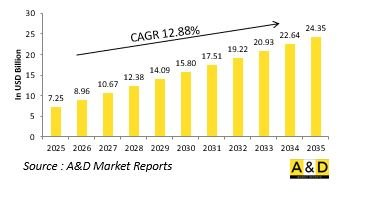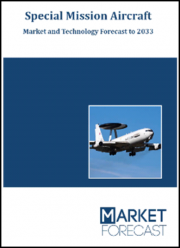
|
시장보고서
상품코드
1811812
세계의 특수 임무 항공기 시장(2025-2035년)Global Special Mission Aircraft Market 2025 - 2035 |
||||||
세계의 특수 임무 항공기 시장 규모는 2025년에 72억 5,000만 달러, 2035년에는 243억 5,000만 달러에 달하고, 예측 기간인 2025년부터 2035년까지 연평균 12.88% 성장할 것으로 예측됩니다.

특수 임무 항공기 시장에서 기술의 영향
특수 임무 항공기에 대한 기술의 영향은 그 설계, 효율성, 작전 범위를 재구성하고 변화를 가져왔습니다. 첨단 작전 시스템은 이러한 플랫폼의 근간을 이루며, 뛰어난 정보 수집, 감시 및 정찰 능력을 제공할 수 있습니다. 최신 레이더, 전기 광학 페이로드 및 신호정보 제품군은 데이터 수집에 있어 타의 추종을 불허하는 선명도를 제공하여 보다 높은 정확도로 작전을 수행할 수 있게 해줍니다. 디지털 항공전자 도입으로 자동화가 진행되어 조종사의 피로도가 감소하고 작전 수행 능력이 향상되고 있습니다. 또한, 연결성도 결정적인 특징입니다. 이 항공기는 현재 광범위한 통신 및 방어 네트워크의 핵심 노드로서 운영되고 있으며, 공중, 육지, 해상에 걸쳐 실시간 데이터를 전송할 수 있습니다. 위성 통신, 암호화된 데이터 링크, 작전 계획 소프트웨어를 통해 동맹군 및 지상 사령부와의 원활한 통합을 보장합니다. 또한, 모듈식 설계가 표준이 되어가고 있으며, 운영자가 최소한의 다운타임으로 작전 페이로드를 교체할 수 있도록 함으로써 빠른 적응성을 제공합니다. 경량 복합재료와 연료 효율이 높은 추진력을 채택하여 항공기의 내구성이 더욱 향상되어 장기간 운용이 가능합니다. 한편, AI의 통합으로 전략의 정확성을 높이는 예측 분석 및 의사결정 지원 도구를 이용할 수 있게 되었습니다. 이러한 발전은 플랫폼의 성능을 향상시킬 뿐만 아니라 현대 작전에서 특수 임무 항공기의 가치 제안을 재정의합니다.
특수 임무 항공기 시장의 주요 촉진요인
특수 임무 항공기 시장의 성장은 전략적 요인, 인도주의적 요인, 기술적 요인의 조합에 의해 좌우됩니다. 지정학적 긴장이 고조되고 전례 없는 안보 위협이 등장함에 따라 상시 모니터링이 가능한 첨단 감시 플랫폼의 필요성이 높아지고 있습니다. 각국 정부는 국경 보안을 강화하고 해상 순찰을 지원하며 대테러 작전을 가능하게 하는 항공기의 중요성을 인식하고 있습니다. 이 항공기는 광범위한 지역을 지속적으로 커버할 수 있는 능력으로 인해 현대의 국방 과제에 대응하는 데 필수적인 존재가 되었습니다. 보안에 그치지 않고 민간용도 점점 더 중요해지고 있습니다. 특수작전용 항공기는 재난구호활동, 환경 모니터링, 의료구조에 있어 귀중한 존재입니다. 자연재해가 발생했을 때, 이러한 플랫폼은 구호물자를 전달하고, 수색과 구조, 통신 회선을 재구축할 수 있는 신속한 수단을 제공합니다. 이러한 다용도성으로 인해 국방 예산의 틀을 넘어 보다 광범위한 사회 복원력에서 정당성을 찾을 수 있습니다. 또한, 경제적, 기술적 고려도 강력한 촉진요인이 될 수 있습니다. 운영자는 여러 작전에 배치할 수 있는 모듈식 항공기의 비용 절감 효과에 매력을 느끼고 있습니다. 또한, 정부와 민간단체는 첨단 기술과 장기적인 내구성을 겸비한 플랫폼을 요구하고 있습니다. 이처럼 국방적 필요성, 민간 용도, 비용 효율성이 복합적으로 작용하면서 특수 임무 항공기는 전 세계적으로 지속적인 투자 우선순위가 되고 있습니다.
특수작전용 항공기 시장의 지역별 동향
특수 작전 항공기 시장의 지역 역학은 지역, 위협 인식, 경제적 우선순위에 따라 형성됩니다. 광활한 해안선과 전략적 수로가 있는 지역에서는 각국이 항로 보호와 어업 보호를 위해 해상 순찰과 밀수 방지 작전이 조달의 대부분을 차지합니다. 이와는 대조적으로 내륙 지역에서는 국경 감시와 정찰이 국경 침입과 불법 거래에 대처하기 위해 국경 감시와 정찰에 우선순위를 둡니다. 이러한 작전 요건의 차이로 인해 고정익 및 회전익 플랫폼에 대한 수요는 매우 광범위합니다.
세계의 특수작전용 항공기 시장에 대해 조사 분석했으며, 성장 촉진요인, 향후 10년간의 전망, 지역별 동향 등의 정보를 전해드립니다.
목차
특수 임무 항공기 시장 보고서 정의
특수 임무 항공기 시장 세분화
용도별
지역별
장비별
향후 10년간 특수 임무 항공기 시장 분석
특수 임무 항공기 시장 기술
세계의 특수 임무 항공기 시장 예측
특수 임무 항공기 시장 동향과 예측 : 지역별
북미
성장 촉진요인 및 억제요인, 과제
PEST
시장 예측과 시나리오 분석
주요 기업
공급업체 Tier 상황
기업 벤치마킹
유럽
중동
아시아태평양
남미
특수 임무 항공기 시장 국가별 분석
미국
방위 프로그램
최신 뉴스
특허
이 시장에서의 현재 기술 성숙도
시장 예측과 시나리오 분석
캐나다
이탈리아
프랑스
독일
네덜란드
벨기에
스페인
스웨덴
그리스
호주
남아프리카공화국
인도
중국
러시아
한국
일본
말레이시아
싱가포르
브라질
특수 임무 항공기 시장 기회 매트릭스
특수 임무 항공기 시장 보고서에 관한 전문가 의견
결론
Aviation and Defense Market Reports에 대해
LSH 25.09.24The Global Special Mission Aircraft Market is estimated at USD 7.25 billion in 2025, projected to grow to USD 24.35 billion by 2035 at a Compound Annual Growth Rate (CAGR) of 12.88% over the forecast period 2025-2035.

Introduction to Special Mission Aircraft Market
Special mission aircraft occupy a critical niche within the aerospace sector, designed to perform highly specific tasks that standard aviation platforms cannot achieve. These aircraft are customized with mission equipment and systems that allow them to serve defense, security, and civil operations with equal significance. Unlike conventional aircraft, their primary value lies in their ability to adapt to environments where intelligence gathering, rapid mobility, or specialized monitoring is essential. Over time, the scope of their missions has widened, ranging from military reconnaissance and electronic intelligence to roles such as environmental monitoring, medical evacuation, and disaster response. This diversity highlights their dual-use appeal, where governments and civilian agencies alike invest in platforms capable of addressing national security, humanitarian, and scientific needs. The market has evolved into a fusion of defense-driven requirements and broader applications. On one hand, the heightened focus on border security, maritime surveillance, and threat detection sustains military procurement. On the other, natural disasters, climate change, and public health emergencies have demonstrated the need for adaptable aerial platforms in civilian roles. This dual dynamic has elevated the sector into a pivotal part of global aviation, attracting sustained attention from established aerospace primes as well as innovative new entrants.
Technology Impact in Special Mission Aircraft Market
The influence of technology on special mission aircraft has been transformative, reshaping their design, efficiency, and operational scope. Advanced mission systems form the backbone of these platforms, allowing them to deliver superior intelligence, surveillance, and reconnaissance capabilities. Modern radar, electro-optical payloads, and signals intelligence suites provide unmatched clarity in data collection, enabling missions to be conducted with higher precision. The incorporation of digital avionics ensures greater automation, which reduces operator fatigue and improves mission execution. Connectivity has also become a defining feature. These aircraft now operate as vital nodes within broader communication and defense networks, capable of transmitting live data across air, land, and sea domains. Satellite communications, encrypted datalinks, and mission planning software ensure seamless integration with allied forces and ground command. In addition, modular designs are becoming standard, offering quick adaptability by enabling operators to swap mission payloads with minimal downtime. The adoption of lightweight composites and fuel-efficient propulsion has further enhanced endurance, allowing aircraft to remain in operation for extended periods. Meanwhile, the integration of artificial intelligence is unlocking predictive analytics and decision-support tools that bolster mission accuracy. Collectively, these advancements not only improve platform performance but also redefine the value proposition of special mission aircraft for modern operations.
Key Drivers in Special Mission Aircraft Market
The growth of the special mission aircraft market is influenced by a combination of strategic, humanitarian, and technological factors. Rising geopolitical tensions and the emergence of unconventional security threats have heightened the need for advanced surveillance platforms capable of constant monitoring. Governments recognize the importance of these aircraft in strengthening border protection, supporting maritime patrol, and enabling counter-terrorism missions. Their ability to provide persistent coverage over large areas makes them indispensable in addressing modern defense challenges. Beyond security, civil applications are increasingly important. Special mission aircraft are invaluable in disaster relief operations, environmental monitoring, and medical evacuation. When natural calamities strike, these platforms offer a rapid means to deliver aid, conduct search-and-rescue, and re-establish communication links. Their versatility ensures that investments extend beyond defense budgets and find justification in broader societal resilience. Economic and technological considerations also act as strong drivers. Operators are attracted to the cost savings of modular aircraft that can be deployed across multiple missions. In addition, governments and private entities seek platforms that combine advanced technologies with long-term durability. This mix of defense necessity, civil application, and cost-effectiveness positions special mission aircraft as a sustained priority for investment worldwide.
Regional Trends in Special Mission Aircraft Market
Regional dynamics in the special mission aircraft market are shaped by geography, threat perceptions, and economic priorities. In areas with vast coastlines and strategic waterways, maritime patrol and anti-smuggling missions dominate procurement, as nations seek to protect sea lanes and safeguard fisheries. Landlocked regions, in contrast, prioritize border surveillance and reconnaissance to counter cross-border infiltration and illicit trade. These differing mission requirements lead to a wide spectrum of demand for both fixed-wing and rotary-wing platforms. Advanced economies tend to focus on modernization and capability enhancement. Their emphasis is on platforms integrated with the latest sensor technologies, electronic warfare suites, and network-enabled capabilities that allow seamless participation in joint operations. Emerging economies, meanwhile, often emphasize affordability and versatility, acquiring platforms that can perform multiple roles with minimal infrastructure support. This balance creates a diverse global marketplace where both high-end solutions and cost-effective adaptations find relevance. Humanitarian and environmental factors also shape regional demand. Regions prone to natural disasters increasingly prioritize aircraft suited for relief and evacuation missions, while areas affected by climate change invest in platforms for monitoring environmental patterns. Collectively, these regional variations highlight how the special mission aircraft market adapts to local realities while maintaining global momentum.
Key Special Mission Aircraft Program:
Diamond Aircraft has finalized a major contract to deliver three DA62 MPP aerial surveillance aircraft to the Greek Ministry of Climate Crisis and Civil Protection. The aircraft will serve multiple roles, including firefighting, search and rescue, aerial surveillance, and functioning as airborne operations centers. Outfitted with advanced electro-optical systems, a cell phone localization capability, and multiple datalinks, they will significantly enhance Greece's capacity to respond to emergencies with greater speed and efficiency. The agreement covers not only the three DA62 MPP special mission aircraft but also ground stations, training, spare parts, and ongoing support. Each platform will be fitted with cutting-edge technology specifically tailored for surveillance and emergency response missions.
Table of Contents
Special Mission Aircraft Market Report Definition
Special Mission Aircraft Market Segmentation
By Application
By Region
By Fitment
Special Mission Aircraft Market Analysis for next 10 Years
The 10-year special mission aircraft market analysis would give a detailed overview of special mission aircraft market growth, changing dynamics, technology adoption overviews and the overall market attractiveness is covered in this chapter.
Market Technologies of Special Mission Aircraft Market
This segment covers the top 10 technologies that is expected to impact this market and the possible implications these technologies would have on the overall market.
Global Special Mission Aircraft Market Forecast
The 10-year special mission aircraft market forecast of this market is covered in detailed across the segments which are mentioned above.
Regional Special Mission Aircraft Market Trends & Forecast
The regional special mission aircraft market trends, drivers, restraints and Challenges of this market, the Political, Economic, Social and Technology aspects are covered in this segment. The market forecast and scenario analysis across regions are also covered in detailed in this segment. The last part of the regional analysis includes profiling of the key companies, supplier landscape and company benchmarking. The current market size is estimated based on the normal scenario.
North America
Drivers, Restraints and Challenges
PEST
Market Forecast & Scenario Analysis
Key Companies
Supplier Tier Landscape
Company Benchmarking
Europe
Middle East
APAC
South America
Country Analysis of Special Mission Aircraft Market
This chapter deals with the key defense programs in this market, it also covers the latest news and patents which have been filed in this market. Country level 10 year market forecast and scenario analysis are also covered in this chapter.
US
Defense Programs
Latest News
Patents
Current levels of technology maturation in this market
Market Forecast & Scenario Analysis
Canada
Italy
France
Germany
Netherlands
Belgium
Spain
Sweden
Greece
Australia
South Africa
India
China
Russia
South Korea
Japan
Malaysia
Singapore
Brazil
Opportunity Matrix for Special Mission Aircraft Market
The opportunity matrix helps the readers understand the high opportunity segments in this market.
Expert Opinions on Special Mission Aircraft Market Report
Hear from our experts their opinion of the possible analysis for this market.














